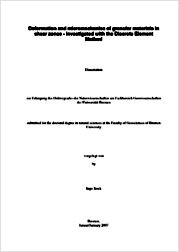Deformation and micromechanics of granular materials in shear zones - investigated with the Discrete Element Method
Kock, Ingo
Univ. Bremen
Monografie
Verlagsversion
Englisch
Kock, Ingo, 2007: Deformation and micromechanics of granular materials in shear zones - investigated with the Discrete Element Method. Univ. Bremen, 138 S., DOI: 10.23689/fidgeo-321.
 |
Dokument öffnen: |
Deformation, shear zone, granular, micromechanic, numerical model, discrete element method, distinct element method. - This thesis was inspired by the lack of detailed (i.e. particle scale) knowledge concerning deformation processes of mechanically weak sediments, especially intrinsically weak layers on the basal shear plane of submarine landslides. It has been known for some time that many different parameters influence shear strength and localization features. This is true not only for sediments, but also for other kinds of weak layers, such as fault gouge. These parameters include for example mineralogy (e.g. smectite, illite, quartz), sediment composition (clay, silt), sediment structure and texture (microfabric), grain size distribution, excess pore pressure, magnitude of effective stress, and deformation history. However, to date it has not been possible to rank or to quantify the influence of each of these parameters. The main goal of this study is to analyze the influence of some of these parameters and, if possible, rank and quantify them. Standard methods to examine shear strength of sediments and fault gouge are various geotechnical shear experiments. In these, a sample is sheared under defined conditions and resulting coefficient of friction, void ratio change, and other meaningful parameters are analyzed. Unfortunately, it is not possible to 'look' inside a shear box during a test and to analyze grain deformation behaviour on a microscopic scale. Therefore, this study employs a different approach to specifically address the problem of microscopic deformation processes. Here, a numerical modelling technique, the Discrete Element Method (DEM), is used. The DEM is a numerical tool based on the ...

